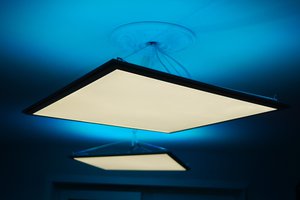Zero is almost exactly the same size in diameter as a quarter.
The program the props are running in the video only turns on 1 led per
step. I only run a single cog, and turn each lead on and then off
sequentially.
The duration of each led's on time is set in the program. I step
through each led in a roation turning each led on and then off.
My peak measurement in current draw was pathetic, 8ma peak. But this
measures draw outside the inrush limiters, not between the prop and cap.
Average peak draw was 7ma for this video. Most any leg could push was through 200ohm (100ohm on led, and 100ohm on common)
16.5ma peak, not even including vf of leds. (3.0vf for blue and green,
2.1vf for red) 2.1vf red = 12ma 3.0vf blue/green = 3ma.
So it seems thats why im seeing 7ma average peak draw.
What happens if I tweak the resistors to the limits of the cree leds.. do I need sunglasses?
These LEDS require a very very low soldering temperature.
The only connection they have between each other is the led emission and detection, no wires, except power.
The speed of the rotation and duration is set by the real.random object
it is kept withing a certain duration to make the zeros stay alive for
the most part.
You don't want them too chatty, but sometimes they keep themselves going for a while.
If a prop transmits red without activating another, the war will stop.
This is an example of using the same led as emitter and detector in the same circuit.
With some random type intelligence, and basic "rules of life"
Optic communication between intelligent 8-core beings?
So i doubled up the leds for this next ZeroHD demo.
64 LEDS I/O on a 32 I/O chip.
16 RGB leds = 64 I/O.
The only limit is that some leds cannot be simultaneously lit.
 ClockLoop
ClockLoop
 Est
Est
 Mikhail Svarichevsky
Mikhail Svarichevsky
